Roof inspections: how we check your roof for issues
 For homeowners who are unfamiliar with how to precisely assess the condition of the roof on their home or commercial building, there can be tremendous relief by having an experienced professional inspect the roof. Not only do experienced
roof inspectors know exactly what to look for, but some inspections even include the use of thermal imaging (infrared cameras) to pinpoint cool areas where leaked moisture has accumulated. Early detection will prevent more extensive water damage, rotting, or mold. In addition to finding hidden pockets of moisture in the decking under the roof, scroll down in this box to see scans of wet ceilings that show up as blue with an IR thermal camera.
For homeowners who are unfamiliar with how to precisely assess the condition of the roof on their home or commercial building, there can be tremendous relief by having an experienced professional inspect the roof. Not only do experienced
roof inspectors know exactly what to look for, but some inspections even include the use of thermal imaging (infrared cameras) to pinpoint cool areas where leaked moisture has accumulated. Early detection will prevent more extensive water damage, rotting, or mold. In addition to finding hidden pockets of moisture in the decking under the roof, scroll down in this box to see scans of wet ceilings that show up as blue with an IR thermal camera.
Besides active leaks, what else is the roof inspection looking for?
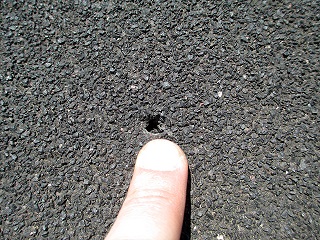
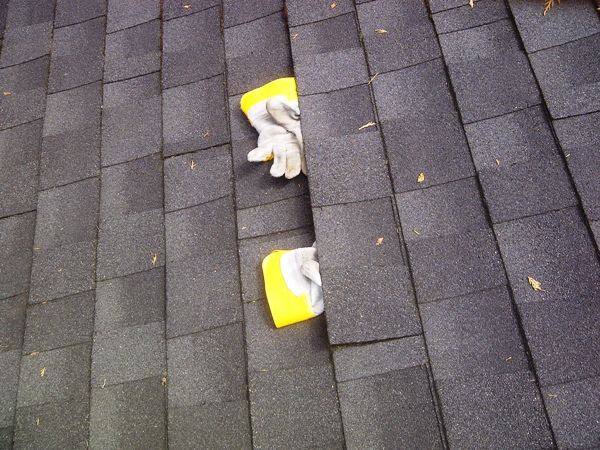 For most roofs, there are two common issues that are assessed to determine the need for
repair or replacement. First, the exterior surface of the roof is the most obvious issue. When inspectors have been asked to get up on the roof and look at it after a hail storm, then they can examine the marks left by the hail and inspect the roof for punctures, cracks, and bruising. Another common issue in Phoenix is shingles that are no longer solidly attached. (Put your mouse over the images to the left and right to learn about the "small-looking" exterior roofing issues and then put your mouse over the images below to see the implications of neglecting to identify and repair small issues.)
For most roofs, there are two common issues that are assessed to determine the need for
repair or replacement. First, the exterior surface of the roof is the most obvious issue. When inspectors have been asked to get up on the roof and look at it after a hail storm, then they can examine the marks left by the hail and inspect the roof for punctures, cracks, and bruising. Another common issue in Phoenix is shingles that are no longer solidly attached. (Put your mouse over the images to the left and right to learn about the "small-looking" exterior roofing issues and then put your mouse over the images below to see the implications of neglecting to identify and repair small issues.)

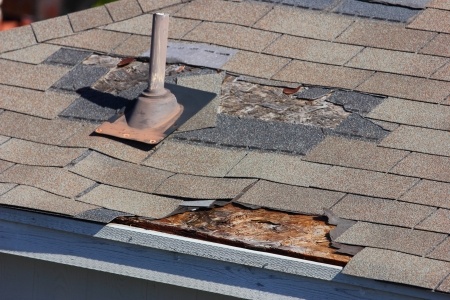 Second, in addition to inspecting the exterior surface of the roofing material, the other important issue (which is not so easy to assess visually) is the condition of the support material directly beneath the exterior roofing (including the decking immediately below the roof exterior). For instance, if significant amounts of moisture have penetrated down through the felt underlayment, then the exterior roofing can have a very weak bond with the underlying material, which may begin to rot.
Second, in addition to inspecting the exterior surface of the roofing material, the other important issue (which is not so easy to assess visually) is the condition of the support material directly beneath the exterior roofing (including the decking immediately below the roof exterior). For instance, if significant amounts of moisture have penetrated down through the felt underlayment, then the exterior roofing can have a very weak bond with the underlying material, which may begin to rot.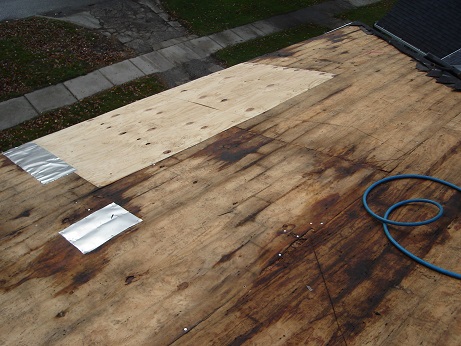 To the right is an image of the plywood decking that was underneath a shingle roof. Notice in the center of the image a pattern of lines that resembles the shape of bricks in a wall. You can see the rectangular shape of some of the water stains that formed around the outlines of the shingles. To the untrained eye, those roof shingles might not have looked like they were at risk for leaking, but they had been leaking badly for a long time!
To the right is an image of the plywood decking that was underneath a shingle roof. Notice in the center of the image a pattern of lines that resembles the shape of bricks in a wall. You can see the rectangular shape of some of the water stains that formed around the outlines of the shingles. To the untrained eye, those roof shingles might not have looked like they were at risk for leaking, but they had been leaking badly for a long time!
Why do weak roofs need to be repaired even without active leaking?
In an area like Phoenix with strong winds expected every summer, it is favorable to repair a weak bond prior to intense storms. It is better to repair the roof prior to the storm in order to avoid a major expense and complication from water damage and interior flooding through leaks into the ceiling caused by hail or wind storms.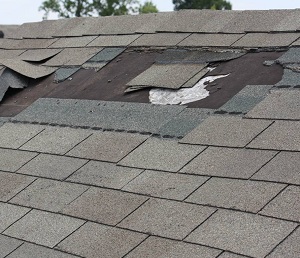 Of course, there is a limit to the value of patching and re-patching a roof! Eventually, roofs will need to be replaced and just adding more patches will be like placing band-aids on a cracking dam. (There are inevitable consequences of trying to get by with repairs when the roof really needs replacing! If you want an outside opinion on the issue, you can contact your home insurance company and ask them about what they think of re-patching a roof that really needs replacing.)
Of course, there is a limit to the value of patching and re-patching a roof! Eventually, roofs will need to be replaced and just adding more patches will be like placing band-aids on a cracking dam. (There are inevitable consequences of trying to get by with repairs when the roof really needs replacing! If you want an outside opinion on the issue, you can contact your home insurance company and ask them about what they think of re-patching a roof that really needs replacing.)
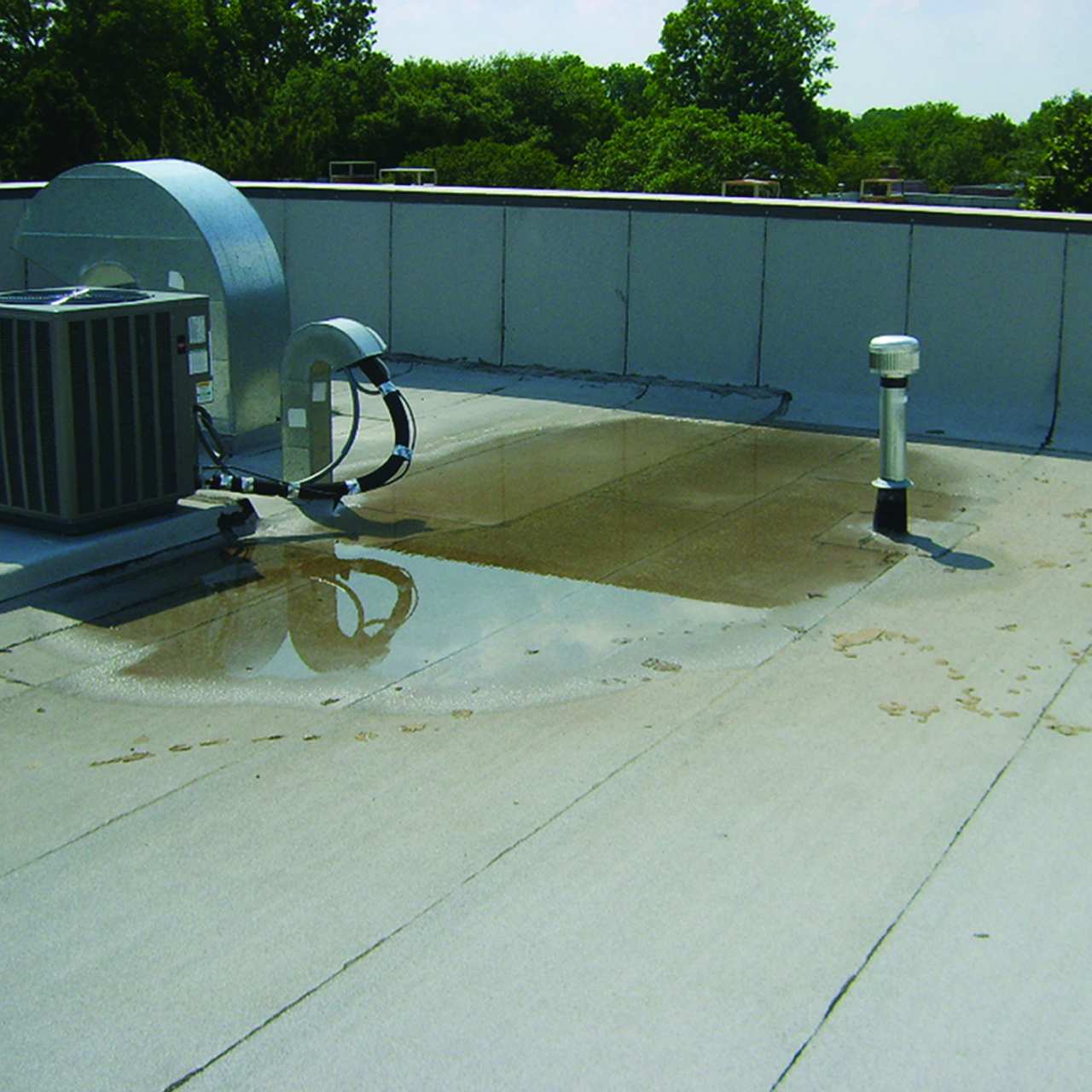
So, not only is the purpose of the roof inspection to examine existing damage to the roof and needs for urgent repair or replacement, but also to prevent major damage to the roof such as a partial collapse. For flat or nearly flat roofs, which are common in Arizona, even a small opening for water can be a big issue when pools of water accumulate after a heavy storm (like in the image to the right).
Insurance companies are usually happy to pay for several hundreds of dollars of repairs if they strongly suspect that the next storm season would cause damage that would result in the need for a water damage restoration service which can be thousands of dollars at a minimum.
Why even minor roof repairs can prevent water damage and mold contamination
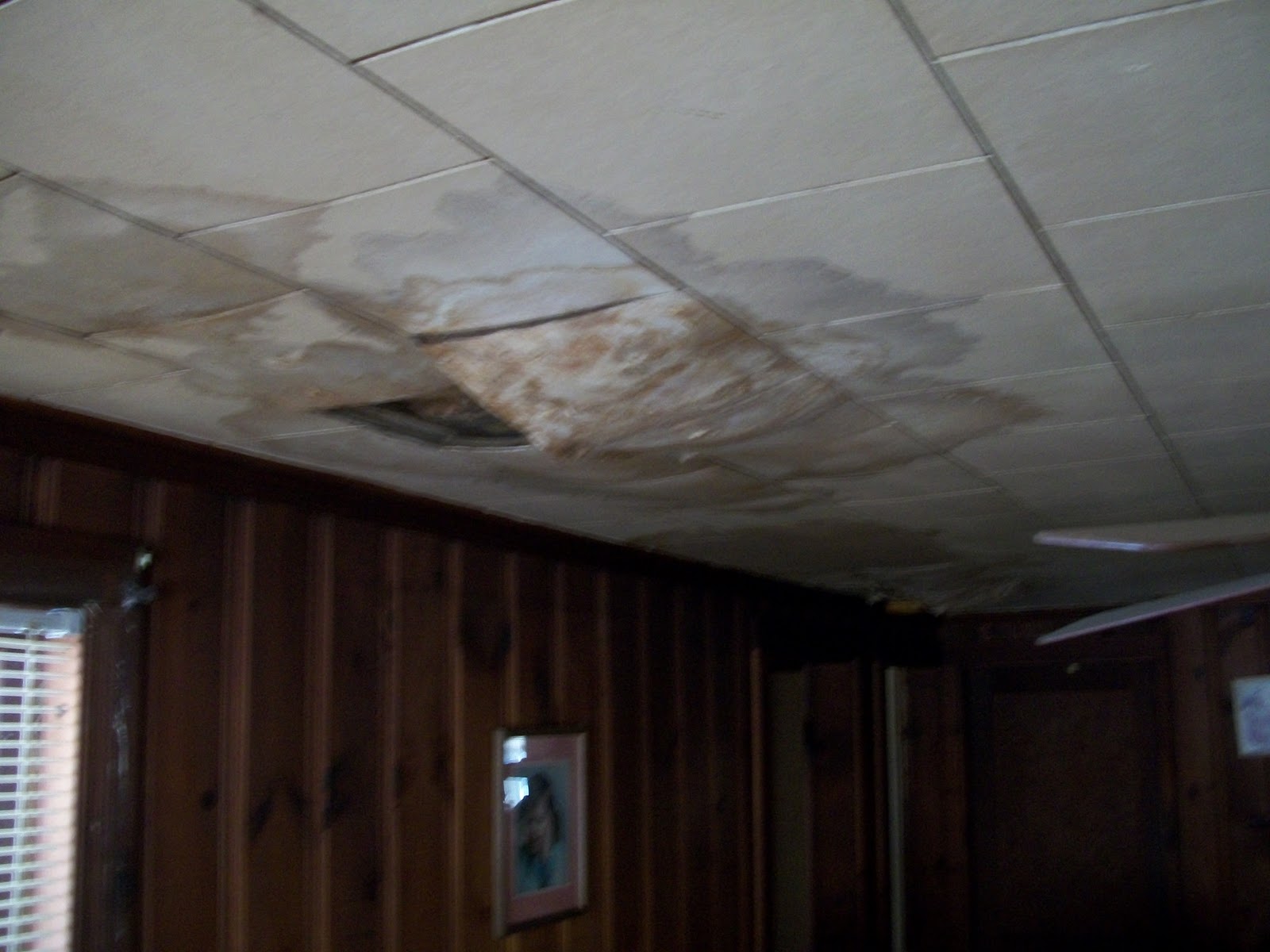 Water damage to your ceiling is a serious problem that it is definitely best to prevent. Hopefully, you also have never experienced the health issues that can be produced by spending time in a building with even moderate mold contamination.
Water damage to your ceiling is a serious problem that it is definitely best to prevent. Hopefully, you also have never experienced the health issues that can be produced by spending time in a building with even moderate mold contamination.
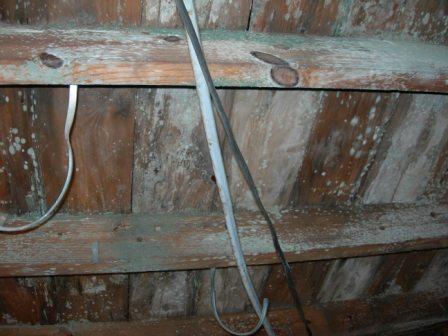 The inconvenience of a brief roof inspection (or even minor repairs or re-roofing) is quite small compared to having a crew of restoration contractors replacing everything: the roof and the ceiling and even the drywall in the interior space (due to
water damage that has leaked through a poorly supported roof). Oddly enough, slow leaks can be even more inconvenient then sudden flooding because the slow leak will almost inevitably produce mold contamination which can result in a large amount of drywall needing to be replaced.
The inconvenience of a brief roof inspection (or even minor repairs or re-roofing) is quite small compared to having a crew of restoration contractors replacing everything: the roof and the ceiling and even the drywall in the interior space (due to
water damage that has leaked through a poorly supported roof). Oddly enough, slow leaks can be even more inconvenient then sudden flooding because the slow leak will almost inevitably produce mold contamination which can result in a large amount of drywall needing to be replaced.
 Basically, with severe mold contamination, large amounts of the interior of the home may need to be carefully removed and then re-built. So, it is obviously favorable to find damage when it is minor or even prevent it from happening through regular roof inspections. On the right above, the plywood in that attic is almost as green as moldy bread!
Basically, with severe mold contamination, large amounts of the interior of the home may need to be carefully removed and then re-built. So, it is obviously favorable to find damage when it is minor or even prevent it from happening through regular roof inspections. On the right above, the plywood in that attic is almost as green as moldy bread!
Why to choose our roofing specialists in Phoenix AZ
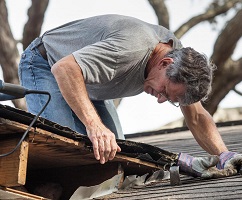 Because our general contractor has been a specialist in the damage restoration industry in Arizona for so long, that gives us some unique advantages, including because of our extensive experience with insurance companies paying for roof damage repairs and water restoration services.
Because our general contractor has been a specialist in the damage restoration industry in Arizona for so long, that gives us some unique advantages, including because of our extensive experience with insurance companies paying for roof damage repairs and water restoration services.
 In particular, we are used to tracking back the source of major interior mold damage to a small leak in the roof. A small leak that goes undetected for a long time can lead to a constant trickle or drip of moisture that penetrates into the interior drywall and results in mold damage that may not be visible until we cut into the drywall. On the left, the water damage shown was a result of the original roofers neglecting to put metal flashing all the way to the edge of the roof, so water dripped in to the plywood wall, rotting it.
In particular, we are used to tracking back the source of major interior mold damage to a small leak in the roof. A small leak that goes undetected for a long time can lead to a constant trickle or drip of moisture that penetrates into the interior drywall and results in mold damage that may not be visible until we cut into the drywall. On the left, the water damage shown was a result of the original roofers neglecting to put metal flashing all the way to the edge of the roof, so water dripped in to the plywood wall, rotting it.
So, we know from lots of personal experience the amount of damage that even small roof leaks can cause. We know how a very small issue that may be nearly invisible from the exterior of the home (at least to an untrained observer) can lead to major restoration costs. We have tracked back from years of mold and rotting wood to find small leak in a roof that could have been repaired for a few hundred dollars at most.
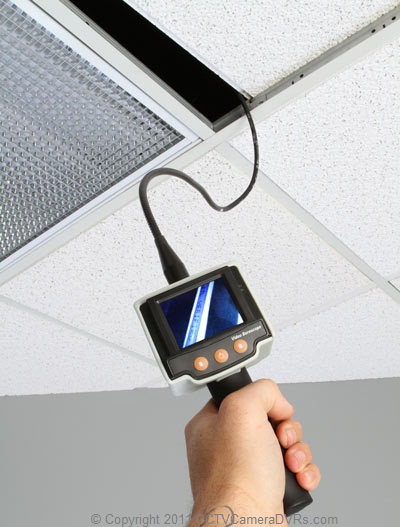 We know that if we find a certain severity of damage to a roof during a roof inspection, then we also can conduct some precise tests to measure the amount of moisture in the walls as well as insert a camera through a small opening to look for signs of mold contamination. Finally, in the next section, you can see several photos that display how thermal imaging technology can provide simple clarity about exactly how much moisture accumulation has been caused by a leaking roof.
We know that if we find a certain severity of damage to a roof during a roof inspection, then we also can conduct some precise tests to measure the amount of moisture in the walls as well as insert a camera through a small opening to look for signs of mold contamination. Finally, in the next section, you can see several photos that display how thermal imaging technology can provide simple clarity about exactly how much moisture accumulation has been caused by a leaking roof.
Using thermal imaging (infrared cameras) to locate the moisture from leaking roofs
We have all seen ugly stains on ceilings caused by a leaking roof. But have you ever seen thermal images that show the cold areas where there is an accumulation of moisture from a roof leak (or from some other source of water)? Take a look at a few of these images and witness the power of this heat-sensing technology to simplify and speed up the process of identify roof leaks early before they lead to major water damage restoration and repairs from areas contaminated by mold.
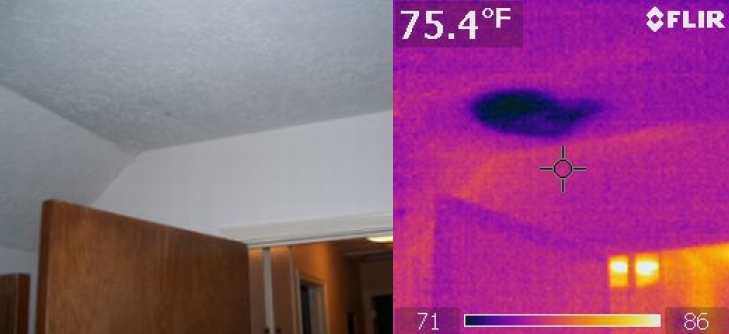
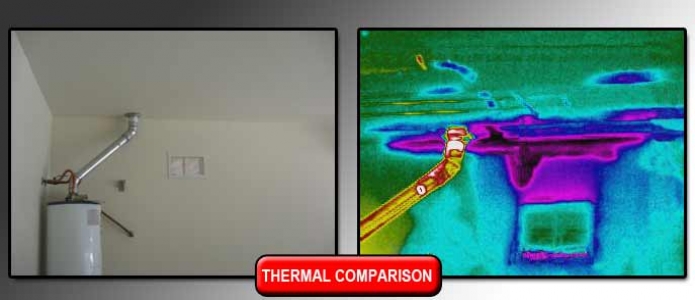

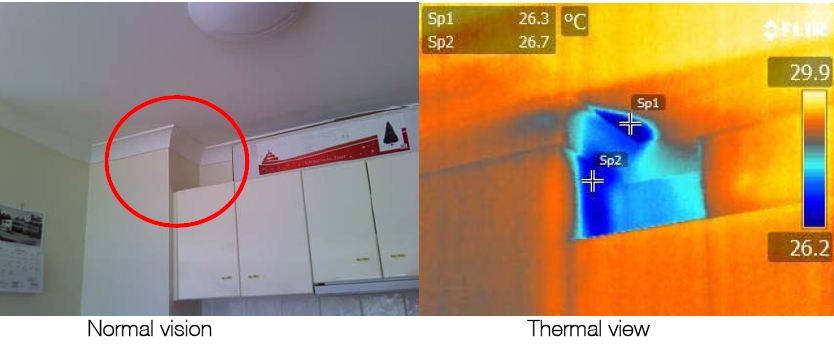
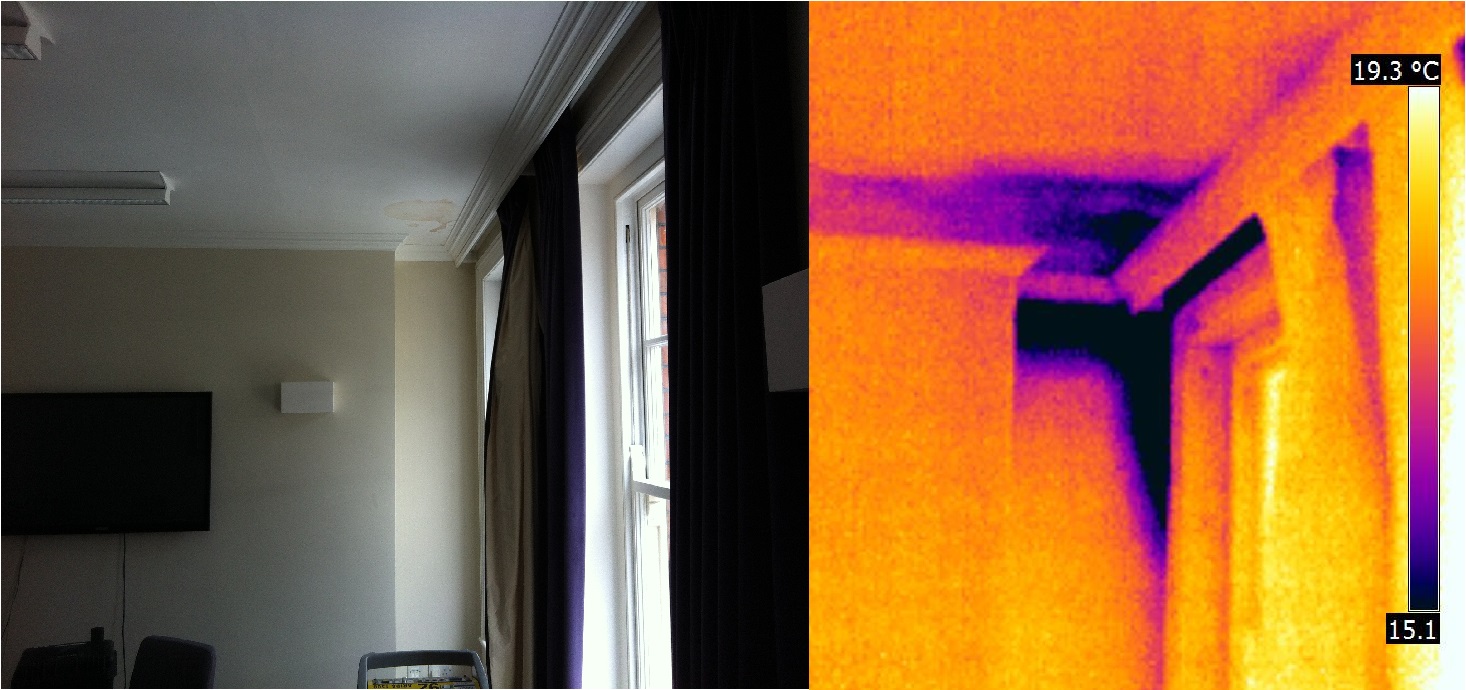
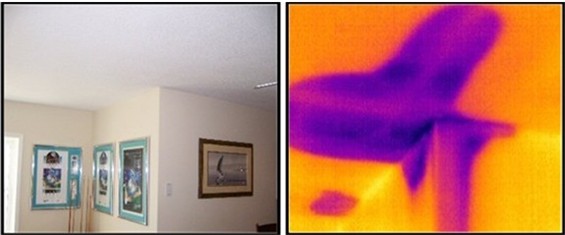
|


